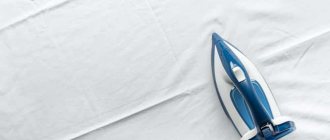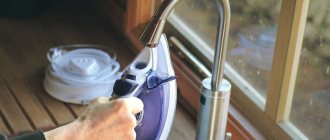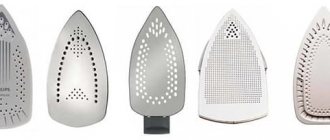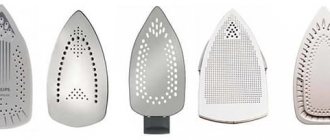Vinegar descaling
To clean scale in your iron using table vinegar, you can pour vinegar and water into the tank:
- To descale your iron, you need to fill the tank one third full with a solution of vinegar and water.
- Then the iron is turned on to maximum heat for 10 minutes. Position the iron so that the water container of the iron is in a vertical position.
- The iron must be plugged in within 10 minutes. If the device turns off, do not interfere with its operation. During this time, the heating elements should be cleared of scale.
- Unplug the device and place a container under it. How to clean the channels and remove scale and rust from the iron - you need to turn on the steam release button.
- The remaining vinegar solution should be drained from the tank.
- After descaling the inside of the device, it is necessary to test the quality of the procedure.
If, after cleaning with a vinegar solution, the amount of steam has increased, and the clothes are not stained with dirty residue, it means that the descaling agent for the iron has helped get rid of plaque and rust.
The process of scale formation depends on the quality of the water used to fill the iron tank and the service life of the device. If after the first cleaning the scale cannot be removed, you can clean it again.
Is it possible to clean an iron with vinegar?
Table vinegar is an acidic agent and can be used to clean scale and burnt marks on household appliances, in particular irons. When applied correctly, the solution eats away the deposits from the inside, after which they peel off from the sole and are easily removed with a damp sponge.
You need to carefully clean the iron with vinegar; when using the product, it is important not to use hard brushes or sponges with an abrasive surface. To prevent the acid from causing damage to the sole, it must first be diluted with water.
Citric acid descaling
A universal descaling agent for irons is citric acid. Every housewife can prepare a liquid for cleaning the iron container from scale. Prepare a solution of citric acid - dissolve the powder in one glass of warm boiled water. To do this, take half a tablespoon of citric acid and stir until completely dissolved.
Instead of citric acid, you can use freshly squeezed lemon juice. There is no need to dilute it with water.
Cleaning your iron from scale with citric acid is as easy as cleaning it with vinegar. By following step-by-step instructions, you can quickly remove scale from your iron.
You can find out how to remove scale from an iron with a steamer in the instructions for the household appliance. We describe in detail how to clean the surface of an iron with citric acid from scale.
Step by step you need to do the following:
- prepare a hot solution of citric acid;
- pour the solution into a special compartment;
- descaling of the iron begins by turning on the device and using the steam function;
- To clean the iron from scale, steam should be passed through the holes several times.
Knowing how to clean scale inside the iron, and outside, on the body and sole, you can extend the life of the device for a long time.
How often should you clean
In order for the electrical appliance to last longer and please the owner with cleanliness, it is necessary to clean the iron with vinegar once every 30 days. It is also important to take preventive measures, then pollution will not form as actively.
To keep the inside of the iron clean, it is better to use filtered or boiled water to steam things. The remaining liquid must be drained to avoid stagnation.
After ironing, the sole should be wiped dry, getting rid of residual moisture and burnt fabric fibers. The latter are formed when the temperature regime is incorrectly chosen. The working surface of the device should not overheat too much, otherwise lint will clog the nozzles and interfere with the normal operation of the iron.
Cleaning the iron coating from carbon deposits
To clean the device from burnt fabric, you need to do it correctly. It is important to remove carbon deposits in such a way as not to scratch the soleplate of the iron. Due to scratches, the metal begins to rust, which means it will not be able to iron things efficiently. Not all irons have a non-stick coating, so models such as Vitek or Bosch should be periodically cleaned of carbon deposits.
You can clean an iron with a steel, stainless, or aluminum sole using gentle abrasives such as salt or soda.
Cleaning the burnt surface of the iron sole with baking soda paste allows you to polish the iron sole to a shine at home. To prepare the paste, mix two teaspoons of baking soda with a small amount of water or vinegar. The consistency of the paste should be soft and thick.
Let's look at the cleaning rules step by step:
- Turn on the iron and warm up the thermal platform until warm.
- Apply the prepared baking soda paste to the surface of the iron and leave for ten minutes.
- Clean the surface of the iron using a cotton cloth.
It is easy to clean the iron with baking soda and gently remove abrasive and burnt residue from the surface of the soleplate of the device.
There are two ways to clean your iron with salt:
- Apply a handful of salt to a slightly heated sole and rub with a cotton cloth;
- Heat the iron to maximum heat, and pour salt onto the cloth or parchment, spreading it in an even layer. Place the iron horizontally for a few minutes, then iron. This will help clean the burnt marks and effectively remove contaminants.
The use of vinegar solution differs from previous methods of cleaning with soda and salt. This solution can be used to clean your iron and ceramic soleplate. This solution can easily clean the holes, surface and soleplate of the iron.
The treatment liquid is prepared by diluting vinegar with water in equal proportions. The iron is cleaned with a cotton cloth soaked in the solution. And holes and hard-to-reach places are cleaned with cotton swabs dipped in a vinegar solution.
Iron parts with steel, ceramic, or stainless soles can be easily cleaned with a vinegar solution.
Melamine sponges should not be used to clean the iron, as this will damage the soleplate of the iron.
Advantages of the cleaning method
There are many ways to remove dirt inside and outside your iron. Vinegar is a remedy that is always available in the house. It is cheap and can be used even on a limited budget. Compared to other methods, such as paraffin and salt, it stands out for its increased efficiency. The only drawback is the unpleasant smell, but it can be easily removed by ventilating the room after cleaning.
To remove stains, you can use 6% or 9% vinegar, but not its essence.
At home, this cleaning method does not cause difficulties. If the need for regular cleaning makes operation less comfortable, you should pay attention to household appliances with a self-cleaning function.
Subscribe to TechnoCouncil on social networks so you don’t miss anything:
A paraffin candle will help remove carbon deposits
For irons with any coating, you can use a paraffin candle.
Proceed as follows:
- Turn on the iron and raise the heat temperature to maximum.
- Place the iron vertically and place an unnecessary thick cloth under the device.
- Wrap a paraffin candle in a cloth and treat the surface of the iron.
Liquid hot paraffin melts the burnt residue. After the dirt has drained off, wipe the surface of the device with a dry cotton cloth.
Methods for ceramics and Teflon
The main condition is not to use any abrasives. Even the smallest and softest particles will leave scratches.
Cleaning Pencil
The cleaning rod contains urea and organic acids. Some manufacturers add aromatic fragrances.
When it comes into contact with a heated sole, the pencil begins to melt. The acids contained in it, under the influence of high temperature, react with carbon deposits and dissolve it.
Procedure:
- open a window in the room, providing an influx of fresh air, since when a pencil comes into contact with a hot surface, a pungent odor is released;
- prepare the area, cover it with old newspapers or cloth, which can then be thrown away;
- heat the iron well, but do not heat it, and unplug it;
- take a pencil and, pressing gently, clean the contaminated areas;
- remove the remains of the melted rod, wipe the sole with a piece of damp cloth.
The final stage is to clean the steam holes with cotton swabs.
Table vinegar
You can clean the ceramic or Teflon soleplate of your iron with vinegar. Here's how to proceed:
- prepare a weakly concentrated acid solution, take 2 tbsp per 200 ml of boiled water. l. 9% vinegar;
- heat the iron slightly;
- take a piece of clean soft cloth, soak it in the prepared solution, and clean off the dirt.
- Wipe the sole with a wet cloth and remove any remaining moisture with a dry cloth.
Advice! Old, stubborn carbon deposits can be cleaned with undiluted 9% vinegar using a rough cloth, such as a waffle towel.
Hydrogen peroxide
Regular 3% peroxide will help clean a ceramic or Teflon iron from minor burnt marks. To do this, you need to heat the device and use a cotton pad soaked in the solution to treat problem areas.
Advice! If the iron cools down, it needs to be reheated again, so the deposits will come off easier.
An analogue of peroxide is hydroperite tablets. You need to dissolve 2 tablets in 100 ml of water, and use the resulting solution to clean the burnt electrical appliance. The active ingredients of the prepared product are hydrogen peroxide and urea. The product is more concentrated and effective compared to regular peroxide.
Ammonia solution
Regular ammonia can be successfully used to clean the surface of the iron. There are several ways:
- Moisten a cotton pad with ammonia and wipe off the resulting residue. Change discs when they become dirty. There is no need to heat the iron.
- Combine ammonia and 9% vinegar in equal proportions, 1 tbsp. l. and thoroughly clean the ironing surface.
- Take 1 tbsp. l. alcohol, add 5-6 drops of fresh lemon juice to it. Wipe off any stains, then clean the sole with a clean, damp cloth.
Advice! Ammonia has a pungent odor, so the procedure should be carried out in a room with an open window or on the balcony.
Laundry soap
You can clean the iron from small deposits with laundry soap. It has a high content of fatty acids and alkalis and copes well with dirt. You must choose 72% soap.
You can use it in two ways:
- Fresh carbon deposits can be easily cleaned with a soapy soft sponge. In this case, the iron should be slightly heated.
- Rub old deposits thoroughly with a soap bar, then heat the device and leave it hot for 3-4 minutes. When the iron has cooled, remove the soap and carbon deposits with a damp sponge.
After the procedure, you need to wipe the surface dry.
Paraffin
You can clean the iron with a simple paraffin candle. In addition to this, you will need a small piece of clean cotton fabric.
- Wrap the candle in cloth, heat the iron to 60-80 °C, usually this corresponds to the minimum setting intended for silk and delicate items.
- Clean the surface of the sole with a makeshift pencil. Upon contact with heat, the paraffin will begin to melt and clean off the carbon deposits.
- Remove the melted mass.
Attention! It is important to hold the iron at an angle so that paraffin does not flow into the steam holes. Otherwise, during subsequent ironing, things can be damaged.
This method is suitable for mild stains.
Products for glass ceramics
They have a liquid consistency, do not contain abrasive particles and do not scratch the surface at all.
The instructions for their use are simple:
- Spray the product and spread it evenly over the base of the electrical appliance.
- Wait 1-3 minutes.
- Wipe with a damp and then dry cloth.
Advice! If the carbon layer is dense and old, the procedure can be repeated twice to completely clean the contaminated device.
Products from the brands Luxus, Sanitol, Silit Bang are popular among buyers.
Cleaning the Teflon surface
Laundry soap helps to clean a Teflon iron well. Clean the Tefal iron cannot be cleaned with acid or abrasive.
Cleaning the iron step by step begins with the following steps:
- Preheat the soleplate of the iron to maximum.
- Clean the soleplate of the iron with laundry soap and rub the surface with a damp cloth.
- Leave the soap for five minutes and wipe the slightly heated sole of the device with a dry cloth to remove black deposits.
- The holes are cleaned with cotton swabs.
- Turn on the iron and iron the unwanted fabric using the steam function.
- After turning on the iron, it is permissible to rinse the soleplate with running water and wipe the iron dry.
Types of coatings
Typically, the soleplate of the iron is made of aluminum or stainless steel. For better glide, a special coating is applied to its surface, which can be different:
- Titanium. Its advantages are durability and strength.
- Ceramic or glass ceramic. This sole glides easily over things and is quickly cleaned, but if handled carelessly, chips and scratches may occur.
- Teflon. The material is resistant to synthetic fabrics even when overheated.
- Enamel. It is difficult to scratch, but may crack over time.
The choice of cleaning method depends on the type of coating. The main task is to completely clean the device from dirt and not scratch the surface.
How to clean your iron using the self-cleaning function
Many modern irons are equipped with a “self-cleaning” function. It is very comfortable.
Here's what you need to do to take advantage of this option:
- Fill the tank with water to the top line.
- Plug in the device and heat it to maximum temperature. Then let it cool and heat it again. This needs to be done at least three times.
- Once the iron has warmed up three times, press the “self-cleaning” button.
- Hold the device horizontally over a bathtub or basin; liquid, dirt, scale, dust and other debris will gradually flow there.
- After cooling, wipe the soleplate of the iron with a soft sponge and rinse the tank thoroughly.
Do not miss
- Do not miss
How to wash a phone case: silicone, matte or transparent (video)
Cautions from experts
There are products that you can use to clean your iron. However, their incorrect use can lead not only to a negative result, but also make the iron inoperable. This applies to the following:
- Incorrectly applied laundry soap or toothpaste can clog the holes in the device and completely ruin it. If the steam release function does not help, it is recommended to use cotton swabs or toothpicks (carefully, without scratching the surface of the iron).
- Avoid using aspirin, vinegar, or nail polish remover if the soleplate of the iron has not yet completely cooled. The fumes from such liquids are poisonous and can have a detrimental effect on your health and can also be life-threatening if the room is small and tightly closed.
- Do not pour vinegar directly onto the iron. It can get inside the device, damaging its internal parts and rubber components. Use swabs soaked in diluted vinegar.
- It is strictly forbidden to use acetic acid in its pure form to clean scale.
- Fine abrasives and table salt are not recommended for use in their pure form. It is necessary to make liquid formulations with their participation. Small particles can get inside the iron, clog it, and make it unsuitable for further use.
Related videos:
Method 1. Salt
Cleaning an iron with salt is very easy, so this method can safely be called one of the most economical and simplest.
Sprinkle salt on a piece of paper or a napkin (preferably sea salt). Turning the steam on to maximum temperature and turning off the steam, begin ironing until the surface of the sole is clean.
How to remove iron marks?
How scale appears
Limescale deposits that form on the soleplate of an iron are one of the two most common problems; the speed of its manifestation depends on the intensity of its use, or due to illiterate handling (for example, incorrect handling of temperature conditions).
Scale appears due to the fact that running water (even filtered water) contains calcium and magnesium salts. The higher the percentage of their content, the more “hard” it is. In modern cities, it is rigid by default, and therefore certain difficulties arise when operating water-consuming equipment.
Of course, water goes through several stages of purification, but it still almost always remains hard. Unfortunately, in most cities, treatment is carried out using outdated treatment systems that are still used by public utilities.
Only in elite premises, which are equipped with an autonomous water supply and heating system, special devices are installed - softeners, thanks to which the rate of scale formation is significantly reduced. Water quality may also vary by region.
The only way to avoid scale from appearing on the soleplate of your iron is to use distilled water. It is not suitable for drinking, since the complete absence of mineral salts will also not be beneficial for the body, but it is quite suitable for technical use.
You can use special filters or bottled water, however, it can also leave behind a small amount of dried salts.
There are three types of scale:
- carbonate, contains calcium and magnesium salts;
- sulfate, contains sulfates;
- silicate, contains acidic silicon calcium-magnesium compounds, which may also contain metals.
Scale, by its mere presence, harms the iron. Scale conducts temperatures about 10 times worse than the steel used in the iron. Because of this, when the device heats up, it cannot be transferred to clothing or the surface of the board. As a result, firstly, the laundry is not ironed properly due to the low temperature, secondly, the metal from which the sole is made overheats, and thirdly, it takes more time to heat the liquid.
Even a thin layer of scale creates a high thermal resistance, which can cause holes and fistulas to appear in the metal.
Preventing contamination of the soleplate of the iron
- Study labels on clothes, find out the properties and characteristics of fabrics.
- Do not violate the temperature regime.
- Iron synthetic and woolen fabrics using a thin, damp cloth.
- Pour filtered water into the liquid reservoir.
- Every time after cooling, wipe the sole with a dry cloth.
- Clean once every six months, even if there are no obvious symptoms of burning.
- Proper care and careful attitude are the key to long and flawless service of a household appliance. The benefits are obvious: saving money and time, plus a good mood to boot.
Causes of scale formation in the iron
Many irons are equipped with a steaming function, which is achieved by using clean water. It is poured into a special compartment. This is where scale forms - a crystal-like deposit, the result of salt deposition. The causes of scale are as follows:
- lack of preventive cleaning of the iron;
- constant presence of liquid in the compartment;
- using tap water, not water purified from all sorts of impurities.
Advice!
To prevent scale from accumulating in the iron, you need to fill it exclusively with distilled water.
Tap water contains a huge amount of salts, so its constant presence in the iron leads to the appearance of a significant coating (white or yellowish) - scale. If it is not removed, then during the ironing process, reddish stains appear on the clothes, which have a negative effect on the fabric and spoil the appearance of the product. Hard flakes may also fall out of the compartment - limescale peeling off. When plaque reaches a critical size, the iron may stop working. The problem needs to be solved radically.
Industrial water purification with vinegar
Naturally, the problem of water pollution with mineral salts is relevant not only at the domestic level, but also in industrial production.
At large industrial facilities, acetic acid is also used to combat scale at the water treatment stage. It is used already at the stage of mechanical cleaning; with its help, limescale deposits accumulated on the filter structures are removed.
Next, the water goes through other stages of purification and softening, this can be an iron remover or an ultraviolet filter.











